 W
WAn altar is a structure with an upper surface for the presentation of religious offerings, for sacrifices, or for other ritualistic purposes. Altars are found at shrines, temples, churches, and other places of worship. They are used particularly in Paganism, Christianity, Buddhism, Hinduism, Judaism, and Modern Paganism. Many historical faiths also made use of them, including the Roman, Greek, and Norse religions.
 W
WA Wiccan altar is a "raised structure or place used for worship or prayer", upon which a Wiccan practitioner places several symbolic and functional items for the purpose of worshiping the God and Goddess, casting spells, and/or saying chants and prayers.
 W
WAltar candles are candles set on or near altars for religious ceremonies. Various denominations have regulations or traditions regarding the number and type of candles used, and when they are lit or extinguished during the services.
 W
WAn altar cloth is used in the Christian liturgy to cover the altar. It is both a sign of awe as well as decoration and protection of the altar and the sacred vessels. In the orthodox churches is covered by the antimension, which also contains the relics of saints.
 W
WIn many Christian churches there is an altar lamp, also known as a chancel lamp, which is found in the chancel (sanctuary), either hanging or fixed. In Anglican, Old Catholic and Roman Catholic churches, the chancel lamp burns before a tabernacle or ambry to demonstrate the belief that Christ is present there through His Real Presence, as the Blessed Sacrament is reserved in these denominations. It is also found in the chancel of Lutheran and Methodist churches to indicate the presence of Christ in the sanctuary, as well as a belief in the Real Presence of Christ in the Eucharist. The sanctuary lamp may also be seen in Eastern Orthodox Churches. Other Christian denominations burn the lamp to show that the light of Christ always burns in a sin-darkened world.
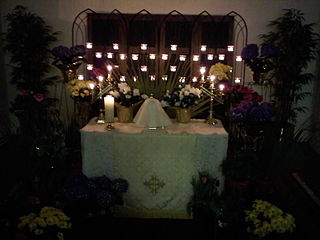 W
WThe altar of repose is an altar where the Communion hosts consecrated on Maundy Thursday during the Mass of the Lord's Supper are placed, or "reserved", for use on the following day, Good Friday. The altar can be found in Roman Catholic, Old Catholic, Anglican, and some Lutheran churches. Good Friday is the day on which the death of Christ is observed. His Resurrection is not observed until Easter Sunday and the anticipatory Easter Vigil on Holy Saturday. Between the time of his death and resurrection, mass is not celebrated, and so communion hosts cannot be consecrated. Any hosts used on Good Friday must have been consecrated previously.
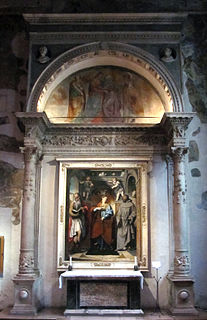 W
WThe Altar of San Girolamo is a sculptural complex in marble, around 780×450×80cm in dimension, designed and constructed by Gasparo Cairano and Antonio Medaglia, and situated within the Church of St Francis of Assisi in Brescia, Italy. Dated between 1506–1510, it is located in the first chapel on the right side of the nave.
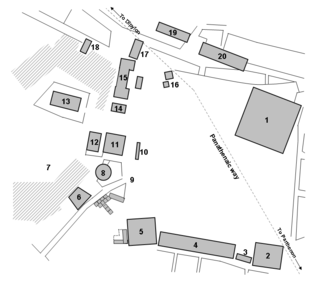 W
WThe Altar of the Twelve Gods, was an important altar and sanctuary at Athens, located in the northwest corner of the Classical Agora. The Altar was set up by Pisistratus the Younger, during his archonship, in 522/1 BC. It marked the central point from which distances from Athens were measured and was a place of supplication and refuge.
 W
WThe Altars for Peace are a series of wooden tables conceived by George Nakashima. Several altars have been placed around the world, beginning with one in the Cathedral of St. John the Divine in 1986. Others are located in Russia, India, and South Africa.
 W
WThe ambon or ambo is a projection coming out from the soleas in an Eastern Orthodox, Oriental Orthodox and Eastern Catholic church. The ambon stands directly in front of the Holy Doors. It may be either rounded or square and has one, two, or three steps leading up to it.
 W
WThe antimins, is one of the most important furnishings of the altar in many Eastern Christian liturgical traditions. It is a rectangular piece of cloth of either linen or silk, typically decorated with representations of the Descent of Christ from the Cross, the Four Evangelists, and inscriptions related to the Passion. A small relic of a martyr is sewn into it.
 W
WBenin ancestral altars are adorned with some of the finest examples of art from the Benin Kingdom of south-central Nigeria.
 W
WChancel flowers are flowers that are placed in the chancel of a Christian church. These chancel flowers are often paid for by members of a congregation as an offering of thanksgiving to God. Chancel flowers are often placed upon or adjacent to the altar table, as well as near other church furniture in the chancel, such as the baptismal font, lectern and pulpit.
 W
WThe Circular Mound Altar is an outdoor empty circular platform on three levels of marble stones, located in Beijing, China. It is part of the Temple of Heaven.
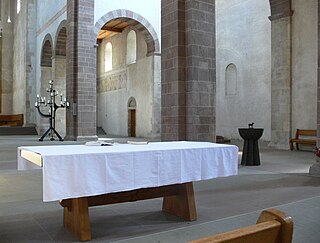 W
WCommunion table or Lord's table are terms used by many Protestant churches—particularly from Reformed, Baptist and low church Anglican and Methodist bodies—for the table used for preparation of Holy Communion. These churches typically prefer not to use the term "altar" because they do not see Communion as sacrificial in any way. However, in colloquial speech, the word "altar" is often used interchangeably with "communion table".
 W
WAltar Q is the designation given to one of the most notable of the rectangular sculpted stone blocks recovered at the Mesoamerican archaeological site of Copán, present-day Honduras.
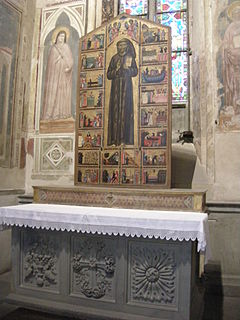 W
WA Dossal, from French dos (back), is one of a number of terms for something rising from the back of a church altar. In modern usage, it primarily refers to cloth hangings but it can also denote a board, often carved or containing a painting, that rises vertically from the back of the altar and to which the cloth is attached. Retable and reredos are alternative terms for solid structures, as is altarpiece, all of them rather more commonly used today.
 W
WThe Altar of Hieron or the Great Altar of Syracuse is a monumental grand altar in the ancient quarter of Neapolis in Syracuse, Sicily. It was built in the Hellenistic period by King Hiero II and is the largest altar known from antiquity.
 W
WA home altar or family altar is a small shrine kept in the home of a Western Christian family used for Christian prayer and family worship. Home altars often contain a cross or crucifix, a copy of the Bible, a breviary, a daily devotional, icons of Jesus Christ and prayer beads, among other religious articles specific to the individual's Christian denomination, for example, the images of the saints for Catholics, the Anglican Rosary for Anglicans, and the Small Catechism for Lutherans.
 W
WThe icon corner, sacred corner or red corner, is a small worship space prepared in the homes of Eastern Orthodox, Greek-Catholic and Roman Catholic Christians. It also appears in homes of Rodnovers and have pre-Christian roots. The analogous concept in Western Christianity is the home altar.
 W
WKamidana are miniature household altars provided to enshrine a Shinto kami. They are most commonly found in Japan, the home of kami worship.
 W
WThe Krodo Altar in Goslar, Germany, is an altar made entirely of bronze and is the only surviving metal church altar from the Romanesque period. It was probably made in the late 11th century. About 1600 it was popularly named after a deity Krodo which is known only from the description and drawing by Cord Bote in his Sassenchronik. It was originally in the Collegiate Church of St. Simon and St. Jude, which was part of the Imperial Palace of Goslar. The altar had been removed by the time the church was demolished (1819–1822) and is now on exhibition in Goslar's Town Museum (Stadtmuseum).
 W
WThe Victor Emmanuel II National Monument, also known as the Mole del Vittoriano or simply Vittoriano, is a national monument built in honour of Victor Emmanuel II, the first king of a unified Italy, located in Rome, Italy. It occupies a site between the Piazza Venezia and the Capitoline Hill. It is currently managed by the Polo Museale del Lazio and is owned by the Ministry of Cultural Heritage and Activities.
 W
WThe Pergamon Altar is a monumental construction built during the reign of the Ancient Greek King Eumenes II in the first half of the 2nd century BC on one of the terraces of the acropolis of Pergamon in Asia Minor.
 W
WThe Prothesis is the place in the sanctuary in which the Liturgy of Preparation takes place in the Eastern Orthodox and Greek-Catholic Churches. Prothesis and diaconicon are collectively referred to as pastophoria.
 W
WThe royal doors, holy doors, or beautiful gates are the central doors of the iconostasis in an Eastern Orthodox or Eastern Catholic church.
 W
WThe soleas is an extension of the sanctuary platform in an Eastern Orthodox temple. The soleas projects beyond the iconostasis, forming a narrow walkway running the full length of the iconostasis.
 W
WThe Stela of Akhenaten and his family is the name for an altar image in the Egyptian Museum in Cairo which depicts the Pharaoh Akhenaten, his queen Nefertiti, and their three children. The limestone stela with the inventory number JE 44865 is 43.5 × 39 cm in size and was discovered by Ludwig Borchardt in Haoue Q 47 at Tell-el Amarna in 1912. When the archaeological finds from Tell-el Amarna were divided on 20 January 1913, Gustave Lefebvre chose this object on behalf of the Egyptian Superintendency for Antiquities instead of the Bust of Nefertiti.
 W
WThe Stripping of the Altar or the Stripping of the Chancel is a ceremony carried out in many Anglican, Catholic, Lutheran and Methodist churches on Maundy Thursday.
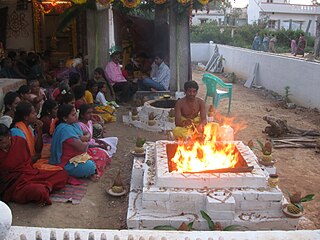 W
WVedi is the sacrificial altar in the Vedic religion. Such altars were an elevated outdoor enclosure, generally strewed with Kusha grass, and having receptacles for the sacrificial fire; it was of various shapes, but usually narrow in the middle.
 W
WA winged altarpiece or winged retable is a special form of altarpiece, common in Central Europe, in which the fixed shrine or corpus can be enclosed by two (triptych), four (pentaptych) or more (polyptych) movable wings. The technical terms are derived from Ancient Greek: τρίς: trís or "triple"; πέντε: pénte or "five"; πολύς: polýs or "many"; and πτυχή: ptychē or "fold, layer".
 W
W W
W